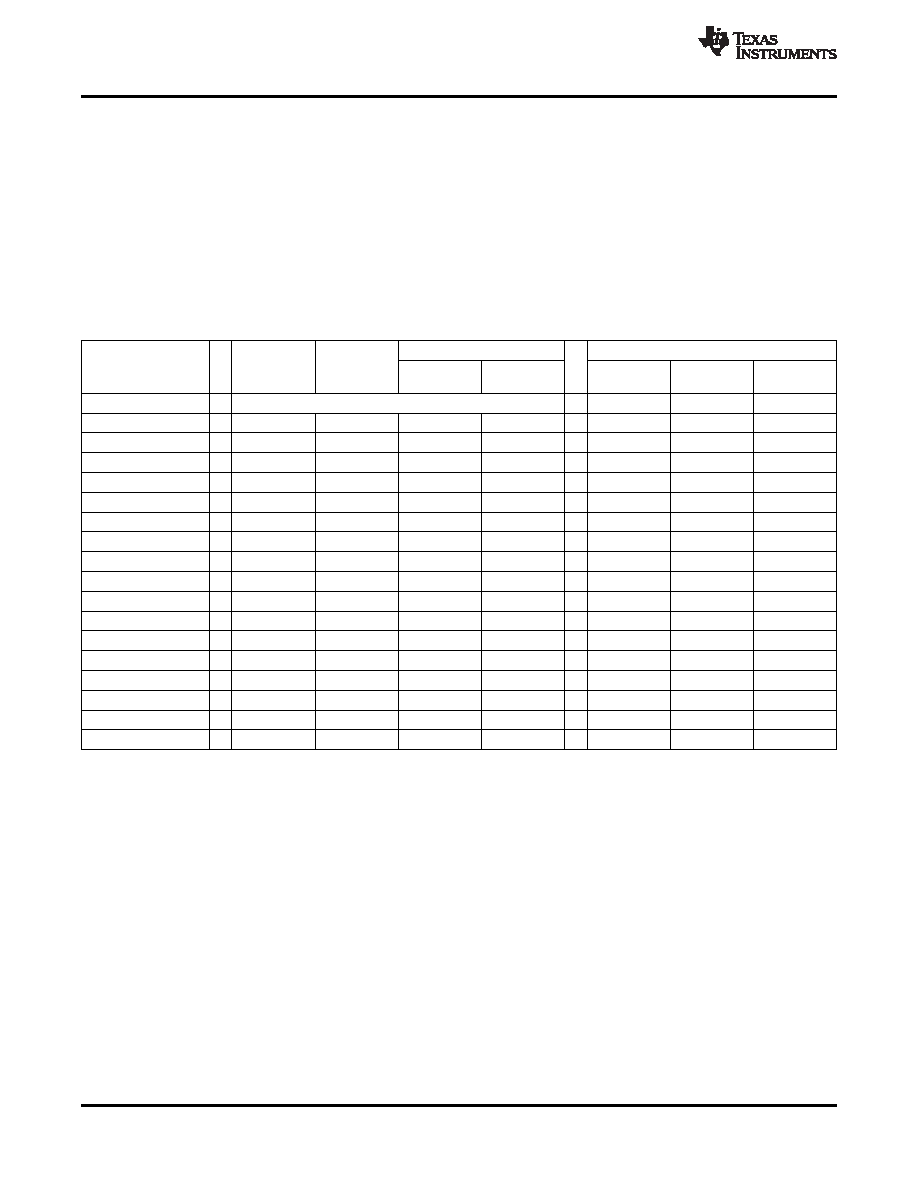- 您現(xiàn)在的位置:買賣IC網(wǎng) > PDF目錄231085 > TPS2552DRVR-1 (TEXAS INSTRUMENTS INC) 1-CHANNEL POWER SUPPLY SUPPORT CKT, PDSO6 PDF資料下載
參數(shù)資料
| 型號(hào): | TPS2552DRVR-1 |
| 廠商: | TEXAS INSTRUMENTS INC |
| 元件分類: | 電源管理 |
| 英文描述: | 1-CHANNEL POWER SUPPLY SUPPORT CKT, PDSO6 |
| 封裝: | GREEN, PLASTIC, SON-6 |
| 文件頁(yè)數(shù): | 8/32頁(yè) |
| 文件大小: | 1025K |
| 代理商: | TPS2552DRVR-1 |
第1頁(yè)第2頁(yè)第3頁(yè)第4頁(yè)第5頁(yè)第6頁(yè)第7頁(yè)當(dāng)前第8頁(yè)第9頁(yè)第10頁(yè)第11頁(yè)第12頁(yè)第13頁(yè)第14頁(yè)第15頁(yè)第16頁(yè)第17頁(yè)第18頁(yè)第19頁(yè)第20頁(yè)第21頁(yè)第22頁(yè)第23頁(yè)第24頁(yè)第25頁(yè)第26頁(yè)第27頁(yè)第28頁(yè)第29頁(yè)第30頁(yè)第31頁(yè)第32頁(yè)

SLVS841D
– NOVEMBER 2008 – REVISED JUNE 2011
ACCOUNTING FOR RESISTOR TOLERANCE
The previous sections described the selection of RILIM given certain application requirements and the importance
of understanding the current-limit threshold tolerance. The analysis focussed only on the TPS2552/53 and
TPS2552-1/53-1 performance and assumed an exact resistor value. However, resistors sold in quantity are not
exact and are bounded by an upper and lower tolerance centered around a nominal resistance. The additional
RILIM resistance tolerance directly affects the current-limit threshold accuracy at a system level. The following
table shows a process that accounts for worst-case resistor tolerance assuming 1% resistor values. Step one
follows the selection process outlined in the application examples above. Step two determines the upper and
lower resistance bounds of the selected resistor. Step three uses the upper and lower resistor bounds in the IOS
equations to calculate the threshold limits. It is important to use tighter tolerance resistors, e.g. 0.5% or 0.1%,
when precision current limiting is desired.
Table 1. Common RILIM Resistor Selections
Resistor Tolerance
Actual Limits
Ideal
Closest 1%
Desired Nominal
Resistor
IOS MIN
IOS Nom
IOS MAX
Current Limit (mA)
1% low (k
)
1% high (k
)
(k
)
(k
)
(mA)
75
SHORT ILIM to IN
50.0
75.0
100.0
120
226.1
226
223.7
228.3
101.3
120.0
142.1
200
134.0
133
131.7
134.3
173.7
201.5
233.9
300
88.5
88.7
87.8
89.6
262.1
299.4
342.3
400
65.9
66.5
65.8
67.2
351.2
396.7
448.7
500
52.5
52.3
51.8
52.8
448.3
501.6
562.4
600
43.5
43.2
42.8
43.6
544.3
604.6
673.1
700
37.2
37.4
37.0
37.8
630.2
696.0
770.8
800
32.4
32.1
32.7
729.1
800.8
882.1
900
28.7
28.4
29.0
824.7
901.5
988.7
1000
25.8
26.1
25.8
26.4
908.3
989.1
1081.0
1100
23.4
23.2
23.0
23.4
1023.7
1109.7
1207.5
1200
21.4
21.5
21.3
21.7
1106.0
1195.4
1297.1
1300
19.7
19.6
19.4
19.8
1215.1
1308.5
1414.9
1400
18.3
18.2
18.0
18.4
1310.1
1406.7
1517.0
1500
17.0
16.9
16.7
17.1
1412.5
1512.4
1626.4
1600
16.0
15.8
15.6
16.0
1512.5
1615.2
1732.7
1700
15.0
14.9
15.2
1594.5
1699.3
1819.4
CONSTANT-CURRENT VS. LATCH-OFF OPERATION AND IMPACT ON OUTPUT VOLTAGE
Both the constant-current devices (TPS2552/53
) and latch-off devices (TPS2552-1/53-1) operate
identically during normal operation, i.e. the load current is less than the current-limit threshold and the devices
are not limiting current. During normal operation the N-channel MOSFET is fully enhanced, and VOUT = VIN - (IOUT
x rDS(on)). The voltage drop across the MOSFET is relatively small compared to VIN, and VOUT VIN.
Both the constant-current devices (TPS2552/53
) and latch-off devices (TPS2552-1/53-1) operate
identically during the initial onset of an overcurrent event. Both devices limit current to the programmed
current-limit threshold set by RILIM by operating the N-channel MOSFET in the linear mode. During current-limit
operation, the N-channel MOSFET is no longer fully-enhanced and the resistance of the device increases. This
allows the device to effectively regulate the current to the current-limit threshold. The effect of increasing the
resistance of the MOSFET is that the voltage drop across the device is no longer negligible (VIN ≠ VOUT), and
VOUT decreases. The amount that VOUT decreases is proportional to the magnitude of the overload condition. The
expected VOUT can be calculated by IOS × RLOAD, where IOS is the current-limit threshold and RLOAD is the
magnitude of the overload condition. For example, if IOS is programmed to 1 A and a 1 overload condition is
applied, the resulting VOUT is 1 V.
16
Copyright
2008–2011, Texas Instruments Incorporated
相關(guān)PDF資料 |
PDF描述 |
|---|---|
| TC1303A-1B2EUNTR | 0.5 A SWITCHING REGULATOR, 2400 kHz SWITCHING FREQ-MAX, PDSO10 |
| TC1303A-1F3EMF | 0.5 A SWITCHING REGULATOR, 2400 kHz SWITCHING FREQ-MAX, PDSO10 |
| TC1303A-1I2EMF | 0.5 A SWITCHING REGULATOR, 2400 kHz SWITCHING FREQ-MAX, PDSO10 |
| TC1303A-1J0EMFTR | 0.5 A SWITCHING REGULATOR, 2400 kHz SWITCHING FREQ-MAX, PDSO10 |
| TC1303A-1M2EMF | 0.5 A SWITCHING REGULATOR, 2400 kHz SWITCHING FREQ-MAX, PDSO10 |
相關(guān)代理商/技術(shù)參數(shù) |
參數(shù)描述 |
|---|---|
| TPS2552DRVT | 功能描述:電源開關(guān) IC - USB Adj Crnt-Ltd Pwr- Dist Sw RoHS:否 制造商:Micrel 電源電壓-最小:2.7 V 電源電壓-最大:5.5 V 最大工作溫度:+ 85 C 最小工作溫度:- 40 C 封裝 / 箱體:SOIC-8 封裝:Tube |
| TPS2552DRVT | 制造商:Texas Instruments 功能描述:PCMCIA Memory Card IC |
| TPS2552DRVT-1 | 功能描述:電源開關(guān) IC - USB Adj Crnt-Ltd Pwr- Dist Sw RoHS:否 制造商:Micrel 電源電壓-最小:2.7 V 電源電壓-最大:5.5 V 最大工作溫度:+ 85 C 最小工作溫度:- 40 C 封裝 / 箱體:SOIC-8 封裝:Tube |
| TPS2552DRVT-1 | 制造商:Texas Instruments 功能描述:PCMCIA Memory Card IC |
| TPS2553 | 制造商:TI 功能描述:intended for applications such as USB where heavy capacitive loads and short-circuits are likely to be encountered capacitive loads and short circuits (More...) |
發(fā)布緊急采購(gòu),3分鐘左右您將得到回復(fù)。